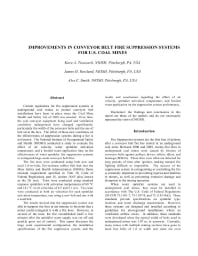Mining Publication: Improvements in Conveyor Belt Fire Suppression Systems for U.S. Coal Mines
Original creation date: March 2010
Authors: KA Teacoach, JH Rowland, AC Smith
NIOSHTIC2 Number: 20036467
2010 SME Annual Meeting and Exhibit, February 28 - March 3, Phoenix, Arizona, preprint 10-209. Littleton, CO: Society for Mining, Metallurgy, and Exploration, Inc., 2010; :1-6
Current regulations for fire suppression systems in underground coal mines to protect conveyor belt installations have been in place since the Coal Mine Health and Safety Act of 1969 was enacted. Over time, the coal conveyer equipment being used and ventilation conditions underground have changed significantly, particularly the width of the conveyor belts and the use of belt air at the face. The effect of these new conditions on the effectiveness of suppression systems during a fire is not known. The National Institute for Occupational Safety and Health (NIOSH) conducted a study to evaluate the effect of air velocity, water sprinkler activation temperature, and a limited water application time on the effectiveness of water sprinkler fire suppression systems to extinguish large-scale conveyor belt fires. The fire tests were conducted using both new and used 1.8-m-wide, fire-resistant rubber belt that met the Mine Safety and Health Administration (MSHA) flame resistant requirement specified in Title 30, Code of Federal Regulations, part 18, section 18.65 (also known as the 2G test). Tests were conducted using standard response sprinklers with activation temperatures of 68 degrees-C and 141 degrees-C at air velocities of 0.5 and 5.1 m/s. Two tests were conducted at both air velocities for each sprinkler activation temperature, one using a new belt and one with a used belt. The results showed that the suppression system was able to suppress the fires in ten minutes to the point that a miner could extinguish it with a fire hose. However, in several of the tests, the fire reestablished itself a few minutes after the sprinkler water supply was cut off and quickly grew out of control. This report discusses the large scale experimental configuration, the installation specifications of the fire suppression system, and the results and conclusions regarding the effect of air velocity, sprinkler activation temperature, and limited water application on the suppression system performance.

NIOSHTIC2 Number: 20036467
2010 SME Annual Meeting and Exhibit, February 28 - March 3, Phoenix, Arizona, preprint 10-209. Littleton, CO: Society for Mining, Metallurgy, and Exploration, Inc., 2010; :1-6
- Improving Prevention and Suppression of Equipment Fires in Metal/Nonmetal Mines
- Diesel Aftertreatment Control Technologies in Underground Mines: The NO2 Issue
- Effect of Air Velocity on Conveyor Belt Fire Suppression Systems
- The Effects of Ventilation and Preburn Time on Water Mist Extinguishing of Diesel Fuel Pool Fires
- Evaluation of the Bagged Stone Dust Barrier Effectiveness in a Bord and Pillar Mine
- Fire Control and Suppression
- Numerical Modeling of Water Spray Suppression of Conveyor Belt Fires in a Large-Scale Tunnel
- Smoke, Carbon Monoxide, and Hydrogen Chloride Production from the Pyrolysis of Conveyor Belting and Brattice Cloth
- Technical Solutions for Enhancements to Mine Safety Using Barricade II Fire Blocking Gel
- Testing and Evaluation of an Inflatable Temporary Ventilation Control Device
- Three Coal Mine Ventilation Studies Using Sulfur Hexafluoride Tracer Gas